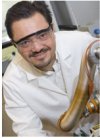Frontiers in Catalysis Science and Engineering
2010
Prof. Raul F. Lobo
Center for Catalytic Science and Technology
Department of Chemical Engineering
"Small Pore Zeolites: Effective Catalysts for the Selective Catalytic Reduction of NOx"
November 17, 2010
EMSL Auditorium - 1:30PM
» Research Highlight: Knocking Out Nitrogen Oxides
Nitrogen oxides (NOx) are a major atmospheric pollutant produced through the combustion of fossil fuels in internal combustion engines and power plants. Copper-exchanged zeolites are promising as selective catalytic reduction (SCR) catalysts for the decomposition of NO using ammonia as the reducing agent. It has been shown before that when fresh, Cu-ZSM-5 has high NH3-SCR activity, however, ZSM-5 zeolites are highly susceptible to dealumination during steaming, which results in a lost of SCR activity. We will show that the NH3-SCR activity of the small-pore zeolites, Cu-SSZ-13, Cu-SSZ-16, and Cu-SAPO-34 is comparable or better than Cu-ZSM-5.
Professor T. Brent Gunnoe
Director, Center for Catalytic Hydrocarbon Functionalization
University of Virginia
"Development of Transition Metal Catalysts for the Hydroarylation of Olefins"
Wednesday, September 29, 2010
EMSL Auditorium - 10:00 AM
» Research Highlight: Controlling Catalysts
Aromatic substrates are prevalent in both commodity chemicals and higher value fine chemicals. Friedel-Crafts catalysts have historically been used to prepare alkyl arenes; however, such systems suffer from drawbacks that are inherent to the mechanism by which the catalysts function. Solid-state catalysts, largely based on zeolitematerials, have provided improvements, but these catalysts are often substrate-specific and are prone to polyalkylation.
Transition metal catalysts can mediate the conversion of aromatic substrates and olefins to alkyl aromatics, and such systems offer opportunities to develop synthetic methods that are complementary (in terms of selectivity) to traditional routes such as Friedel-Crafts catalysis. However, substrates are often limited to heteroaromaticsor compounds that possess activating groups. The presentation will cover studies of Ru(II) catalysts for the hydroarylationof olefins of the type TpRu(L)(NCMe)Ph {Tp= hydridotris(pyrazolyl)borate; L = CO, PMe3, P(Npyrrolyl)3 or P(OCH2)3CEt} with a focus on structure/activity relationships (as a function of the ligand"L") as well as recent results toward the development of Pt(II) catalysts.
Professor Dionisios G. Vlachos
Elizabeth Inez Kelley Professor
Director of Catalysis Center for Energy Innovation
Director of Catalytic Science and Technology
University of Delaware
"Complexity and emergent behavior in catalytic reactions: CO oxidation on gold, biomass processing, and
ammonia decomposition"
Monday, September 13, 2010
EMSL Auditorium - 1:00 PM
» Research Highlight: Getting the Catalysts You Really Need
In this talk, complexity and emergent behavior of catalytic reactions will be presented with main focus on understanding reaction pathways, particle size and shape effects, and discovery of novel catalytic materials. Three prototype reactions will be discussed: CO oxidation on Au supported on MgO, biomass processing, and ammonia decomposition for hydrogen production. We use multiscale modeling, combining density functional theory with kinetic Monte Carlo simulations, to understand the overall activity of CO on Au particles and small clusters. We find that oxygen vacancies are critical in enabling charge transfer and thus molecular oxygen adsorption. Carbonate poisoning and catalyst restructuring are key processes in understanding activity of Au clusters. In the case of ammonia, phenomenal structure sensitivity of ammonia is found experimentally by combining EXAFS, TEM, chemisorption, and reactivity data. In particular we show that not only size but also particle shape can affect activity dramatically. Multiscale modeling is in excellent agreement with data. An approach to predicting best catalytic bimetallic materials is discussed and demonstrated experimentally. Finally, challenges and recent progress in modeling the selective conversion of biomass derivatives to chemicals are discussed.
Professor George Huber
Armstrong Assistant Professor of Chemical Engineering
University of Massachusetts
"Breaking the Chemical and Engineering Barriers to Lignocellulosic Biofuels"
Tuesday, July 13, 2010
EMSL Auditorium - 10:00 AM
» Research Highlight: Breaking through the Barriers to Biofuels
Concerns about global warming and national security, combined with the diminishing supply and increased cost of fossil fuels are causing our society to search for new sources of transportation fuels. In this respect plant biomass is the only sustainable feedstock that can be used for production of renewable liquid fuels. Currently cellulosic biomass is significantly cheaper than petroleum (at $15 per barrel of oil energy equivalent) and abundant. However, the chief impediment to the utilization of our biomass resources is the lack of economical conversion processes.
In this presentation we will discuss various pyrolysis based approaches for the conversion of lignocellulosic biomass into fuels and chemicals. Pyrolysis is the thermal decomposition of biomass into a mixture of semi-volatile molecules. These pyrolysis vapors can then be condensed into a bio-oil or pyrolysis oil that contains more than 300 compounds. This pyrolysis oil is the cheapest liquid fuel made from biomass. However, this oil is unstable, acidic, insoluble with petroleum based fuels, has a high oxygen content, and polymerizes with time. Alternatively, biomass can be depolymerized by hydrolysis approaches. We will compare these two methods of depolymerizing biomass.
The resulting bio-oil can be converted into various fuels and chemicals by aqueous-phase hydrodeoxygenation. Three reaction classes occur in hydrodeoxygenation of biomass: C-C bond cleavage, C-O bond cleavage, and hydrogenation. The key C-C bond cleavage reactions include: retro-aldol condensation and decarbonylation which both occur on metal catalytic sites. Dehydration is the key C-O bond cleavage reaction and occurs on acid catalytic sites. Hydrodeoxygenation of the aqueous phase of bio-oil can produce C1-C6 alkanes, alcohols, and polyols. This research suggests that hydrodeoxygenation chemistry can be tuned to make a wide variety of products from pyrolysis derived feedstocks.
Addition of zeolite catalysts into the pyrolysis reactor can directly produce gasoline range aromatics from biomass by an approach we call catalytic fast pyrolysis (CFP). The pyrolysis vapors enter directly into the zeolite pores where they undergo a series of dehydration, decarbonylation and oligomeriation reactions. The shape, pore structure, and active sites of the zeolite catalysts are critical in obtaining high yields of the desired aromatic products. CFP has several advantages compared to other biomass conversion technologies in that a liquid fuel is being produced directly from solid biomass in a single catalytic reactor, short residence times, and inexpensive catalysts are used.
We believe that pyrolysis based technologies have a tremendous potential for the conversion of lignocellulosic biomass into renewable fuels and chemicals. As will be demonstrated in this presentation chemistry, chemical catalysis and chemical engineering are critical 21st century needs to help make renewable energy a practical reality.

Professor Abhaya Datye
Distinguished Regent' Professor of Chemical & Nuclear Engineering
Nanoscience & Microsystems degree program director
Center for Micro-Engineered Materials
University of New Mexico
"Bimetallic PdZn Catalysts for the Steam Reforming of Methanol"
Monday, March 17, 2010
EMSL Auditorium - 1:30 PM
» Research Highlight: Imaging Atoms and Revolutionizing Laptop Computers
While Cu is known to be highly active and selective towards the steam reforming of methanol, group VIII metals, such as Pd, favor methanol decomposition to CO and H2. Iwasa et al. (Catalysis Letters, 1993. 19(2-3): p. 211.) were the first to report that Pd becomes highly active for reforming and selective towards CO2 when supported on ZnO and reduced at temperatures above 300°C. This was attributed to bulk PdZn alloy which was formed by the spill-over of atomic hydrogen from the Pd metal to the ZnO, leading to facile reduction of the ZnO and migration of Zn to the metallic surface. The extent of alloy formation increased at higher reduction temperatures, but the overall conversion was unaffected by the increase in crystallite size of the PdZn phase (see figure below). The apparent lack of correlation between reactivity and the surface area of the PdZn phase (which decreases as crystallite size increases) suggests that the PdZn may not be the only catalytically active phase, and we suspect that the ZnO may also play an important role in this reaction. We will present a systematic study of methanol reforming reactivity on model bimetallic alloy powders and powder catalysts that contain ZnO of well defined morphology, to shed light on the nature of the active phase in methanol reforming catalysts based on Pd.

Shown is a realistic model of a key interface in dye-sensitized solar cells.
Joost VandeVondele
University of Zurich
Monday, March 1, 2010
EMSL/1077
» Research Highlight: Cutting Through Questions for a Molecular-Level Understanding of Solar Cells

Jingguang G. Chen
Jingguang G. Chen
Center for Catalytic Science and Technology
Department of Chemical Engineering
University of Deleware
"Experimental and Theoretical Studies of Cathode Electrocatalysts for Fuel Cells"
Wednesday, February 24, 2010
ETB/Columbia River Room
9:00 AM - 10:00 AM
Recently our research group has performed experimental and theoretical studies of the novel catalytic and electrocatalytic properties Pt-based bimetallic alloys, in particular the subsurface Pt-3d-Pt (3d = Ni, Co, Fe) structures [1-3]. Our research approaches are aimed at bridging the "materials gap" and "pressure gap" using a combination of DFT calculations, UHV studies on single crystal and polycrystalline surfaces, and reactor and fuel cell studies of supported catalysts. In the current talk we will present our recent results on the advantages and challenges of using Pt-3d-Pt as cathode electrocatalysts for PEM fuel cells.
We will first correlate the enhanced Oxygen Reduction Reaction (ORR) activity with the binding energy of atomic oxygen on different bimetallic surfaces. We will then address the most critical question for the application of Pt-3d-Pt for ORR application, the stability of the subsurface structure in the presence of adsorbed oxygen. We will provide DFT calculations of the thermodynamic stability and experimental measurements of the segregation kinetics of subsurface 3d atoms in the presence of oxygen on single crystal Pt-3d-Pt(111) structures. These results will be correlated with segregation kinetics of the corresponding bimetallic structures on polycrystalline films, measured both under UHV [4,5] and atmospheric [6] conditions. We will also confirm the segregation and dissolution of subsurface 3d metals using an electrochemical half cell that is attached to a UHV system. Finally, we will propose the possibility to overcome the intrinsic instability of the Pt-3d-Pt structure by anchoring the subsurface 3d atoms on the substrates of transition metal carbides.
[1] Chen, Menning & Zellner, Surface Science Reports, 63 (2008) 201-254.
[2] Murillo, Goda & Chen, J. Am. Chem. Soc. 129 (2007) 7101.
[3] Skoplyak, Barteau & Chen, ChemSusChem. 1 (2008) 524
[4] Menning & Chen, J. Chem. Phys. 128 (2008) 164703
[4] Menning & Chen, J. Chem. Phys. 130 (2009) 174709.
[5] Menning & Chen, J. Power Sources, 195 (2010) 3140.
2009

Dr. Stefan Vajda
Dr. Stefan Vajda
Argonne National Laboratory
Chemical Sciences and Engineering
"Bond-Selective Chemistry on Catalysts Designed
at the Subnanometer to the Nanometer Scale"
Tuesday, September 8, 2009
EMSL/Auditorium
1:00 PM - 2:00 PM
» Research Highlight: Small, Smaller, Smallest
The elucidation of the correlation between the size/composition/shape of a catalyst and its function are instrumental on the way to the design of new classes of catalytic materials. Highly uniform particles on technologically relevant supports are prerequisites for such studies.
The experimental studies are based on 1) chemically uniform support fabrication, 2) size-selected cluster deposition, 3) electron microscopy of nanoclusters, and 4) in situ synchrotron X-ray characterization of clusters under working conditions, combined with mass spectroscopy analysis of reaction products.
1) Selective activation of the C=C bond in propene to form propylene oxide on alumina supported Ag nanoparticles and clusters. The size-dependent activity and selectivity of Ag nanoparticles will be compared with the performance of sub-nanometer Ag3 and Au6-10 clusters. The subnanometer gold catalyst performs without the commonly used TiO2 support and hydrogen additive.
2) Selective dehydrogenation of propane on Pt8-10 clusters. Pt clusters on mesoporous membranes identify the first viable Pt-based catalyst composition which, while the most selective under oxidative conditions, outperforms by a factor of 40 to 100 the activity of the best reported Pt-based and VOx-based catalysts, respectively.
3) As time will allow, methanation & Fischer-Tropsch reactions on size-selected nickel and cobalt clusters are chosen to illustrate the recent addition of simultaneous X-ray absorption to the temperature-programmed reaction & X-ray scattering approach. Pronounced size, composition and support effects on catalyst performance are observed.
 Prof. Dr. Jean-Pierre Gilson
Prof. Dr. Jean-Pierre GilsonProf. Dr. Jean-Pierre Gilson
Director, Laboratoire Catalyse & Spectrochimie
Caen, France
"New Insights on Zeolite Chemistry by Advanced IR and NMR Characterization Tools"
Tuesday, June 23, 2009
EMSL Auditorium
10:00 AM - 11:00 AM
Research Highlight: Teaching Catalysts to Play Ball
New techniques and methodologies in the spectroscopic characterization of zeolites are yielding new insights in the complexity of zeolitic materials. In particular, emerging IR and NMR techniques shed new lights on old problems such as acidity. New, rich, and quantitative information can be gathered. In particular, the ability to work under the operando conditions yields much valuable data to rationally design better catalysts or zeolite-based materials. The following points will be discussed:
- Accessibility of active (acid) sites
- Size & basicity: the problem of substituted pyridines
- Confinement & basicity: Acetonitrile in Si-MOR
- Quantifying the IR signal of adsorbed molecules
- IR operando spectroscopy
- HP 129Xe NMR.
Dr. Marc J.A. Johnson
University of Michigan
"Tuning the Strength and Reactivity of Metal-Ligand Bonds: Reactive Nitrides and Stable Carbides in Catalytic Multiple-Bond Metathesis Reactions"
Tuesday, March 31, 2009
EMSL Auditorium
10:00 AM - 11:00 AM
Modification of the ancillary ligand set can be used to tune the relative strength of metal-element multiple bonds rationally. New nitride complexes of Mo and W that are activated toward triple bond metathesis are described. In the case of W, pairwise nitride/alkylidyne exchange can be reversible, leading to a new catalytic reaction, nitrile-alkyne metathesis.
2008
Speakers have included:
Prof. Dr. Johannes Lercher
Technischen Universitat Munchen
"Catalytic activation of hydrocarbons in confined spaces"
Tuesday, August 26, 2008
EMSL Auditorium
10:00 AM - 11:00 AM
The lecture addresses the elementary steps involved in the conversion of hydrocarbons at acid sites in well-defined environments. These steps include, transport to and sorption on sites in and outside the pores, the addition of protons and the abstraction of hydrogen as initiating steps, the surface reaction and finally the desorption of the products.
Prof. Dr. Cynthia M. Friend
Harvard University
"Chemical reactivity and surface restructuring at the nanoscale: Oxidation reactions promoted by Au"
Tuesday, March 18, 2008
EMSL Auditorium
9:30 AM 10:30 AM
Due to the catalytic importance of oxidation reactions at low temperature, Au is under intense investigation as a component in low-temperature catalysts since Haruta discovered that Au nanoparticles are active for these processes.
Prof. Dr. Peter C. Stair
Northwestern University and Argonne National Laboratory
"The chemical nature of supported vanadium oxide"
Wednesday, January 30, 2008
EMSL Auditorium
2:00 PM 3:00 PM
Vanadium oxide supported on alumina, silica, titania, zirconia, and other oxides is one of the most extensively studied catalyst materials. The catalytic performance of supported vanadia has been investigated for a variety of hydrocarbon transformations, especially the oxidative dehydrogenation of alkanes and the oxidation of methanol in order to establish the relationship between the chemical, physical, and structural nature of supported vanadia and its catalytic function.








